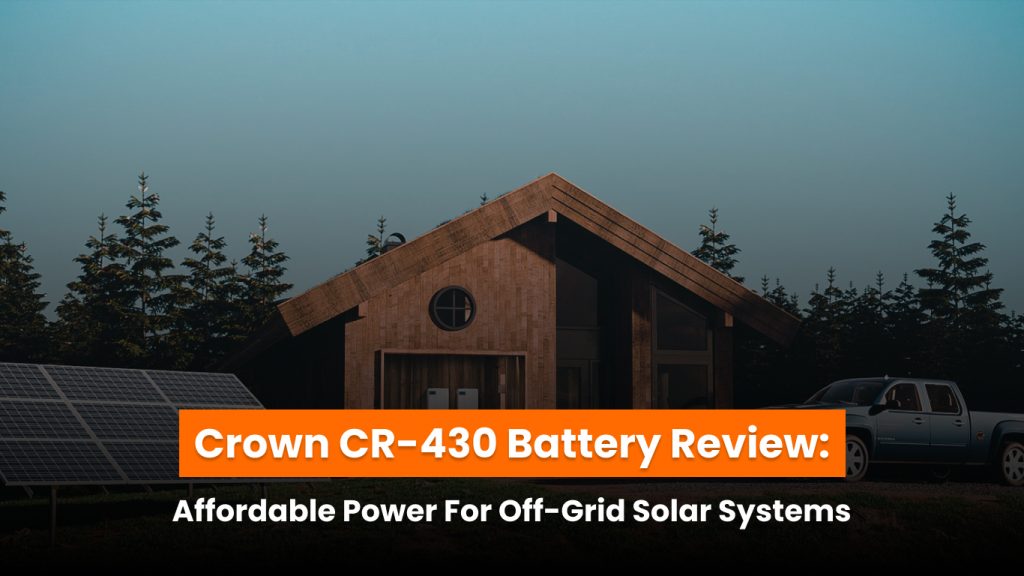When it comes to solar energy storage, not every battery fits every situation—or every budget. That’s where the Crown CR-430 flooded lead-acid battery stands out. It’s a practical, budget-friendly option for people who want to dive into off-grid living or build a robust solar battery bank without breaking the bank.
In this review, we’ll explore what makes the Crown CR-430 such a popular choice. We’ll also discuss the pros and cons of flooded lead-acid batteries, compare them with other battery types, and explain why this model might be the right fit for your solar setup.
What is the Crown CR-430?
The Crown CR-430 is a flooded lead-acid deep cycle battery, designed primarily for off-grid solar energy storage. It’s a 6-volt battery with a capacity of 430 amp-hours (measured over a 20-hour rate), which makes it well-suited for medium-to-large solar setups such as off-grid homes or cabins.
Here’s a quick look at its core specifications:
- Model: Crown CR-430
- Nominal voltage: 6V
- Capacity: 430 amp-hours
- Dimensions: 12.38″ x 7.19″ x 15.29″
- Weight: 122 lbs
- Estimated cycle life: ~1200 cycles at 50% depth of discharge
- Price: $399.95 (As of April 2025)
But what exactly does all this mean? Let’s break down some of the technical terms.
What is a flooded lead-acid battery?
Flooded lead-acid batteries are the oldest type of rechargeable battery still in use today, dating back to the 1850s. They contain liquid electrolyte (a mixture of water and sulfuric acid) and require regular maintenance—typically topping off with distilled water and performing equalization charges to prevent performance issues.
These batteries are deep cycle, meaning they’re designed to be discharged and recharged many times, making them ideal for solar applications where energy is stored and used daily.
Why choose the Crown CR-430?
The CR-430 isn’t flashy, but it’s incredibly reliable. Let’s explore the key reasons people choose this battery for solar storage.
Low upfront cost
If you’re working within a budget, the CR-430 is one of the most affordable ways to store solar energy. For just over $300, you get a high-capacity battery with a competitive cycle life—about 1200 full cycles when discharged to 50% each time.
By comparison, a sealed battery like the Fullriver DC400-6 costs nearly twice as much (around $583) for a similar lifespan. So, if you’re comfortable with the maintenance, you’re getting more storage for your dollar with Crown.
This makes the CR-430 one of the best cost-per-cycle values on the market.
Proven technology
Flooded lead-acid batteries have a long track record. Unlike newer battery chemistries like lithium-ion, which are still being refined, flooded batteries are a mature technology. Their chemistry is well understood, they’re predictable in performance, and they’ve stood the test of time—literally for over 160 years.
This level of reliability is important when you’re building an off-grid system that needs to be dependable day in and day out.
Strong manufacturer reputation
Crown Battery is one of the oldest and most respected manufacturers of lead-acid batteries in the United States. Founded in 1926, the company operates out of Fremont, Ohio, where they continue to produce their products domestically.
Crown is known not just for quality products, but also for their strong customer support and educational initiatives. They work closely with installers and partners to provide training and technical support, helping customers get the most out of their battery systems.
Downsides to consider
Of course, no battery is perfect. Here are a couple of limitations you’ll want to keep in mind before choosing the Crown CR-430.
Requires regular maintenance
Flooded batteries require more attention than sealed or lithium alternatives. Every month, you’ll need to:
- Check fluid levels and top off with distilled water as needed.
- Perform equalization charges, which are controlled overcharges that help remove buildup on the battery plates and keep the cells balanced.
Neglecting this maintenance can significantly shorten the lifespan of your battery. While these tasks are relatively quick and easy, you’ll need to stay on top of them consistently.
If the idea of ongoing maintenance feels overwhelming, you might prefer a sealed AGM or lithium battery, which are essentially maintenance-free.
Must be installed in a ventilated space
Flooded lead-acid batteries off-gas hydrogen during the charging process. Because of this, they cannot be installed indoors unless you have a ventilation system in place. The safest bet is to place them in a battery enclosure outdoors or in a detached garage or shed.
This requirement may add extra costs to your installation, especially if you need to build a new structure or retrofit an existing space.
Who is this battery best for?
The Crown CR-430 is ideal for full-time off-grid homes where the battery will be used daily and maintained regularly. It’s a good fit for homesteaders, remote cabins, or rural properties that rely on solar as the primary energy source.
Because flooded batteries self-discharge faster than sealed or lithium types, they’re not a good choice for seasonal or part-time properties like vacation homes or hunting cabins. In those cases, sealed batteries are the better option.
Final thoughts
The Crown CR-430 remains a top pick for anyone building a cost-effective off-grid solar system. It delivers solid performance, reliable technology, and impressive longevity for the price—provided you’re willing to keep up with maintenance.
If you’re looking for an affordable way to store solar energy, this battery is hard to beat. But if low maintenance or indoor installation is a must for you, you may want to explore sealed AGM or lithium options instead.
Need help sizing your battery bank or deciding if the CR-430 is right for your setup? Reach out to Sunhub!
Our solar professionals are here to guide you through the selection process and make selling or installing solar products easier. Whether you’re new to solar or scaling your business, we’ve got your back.

